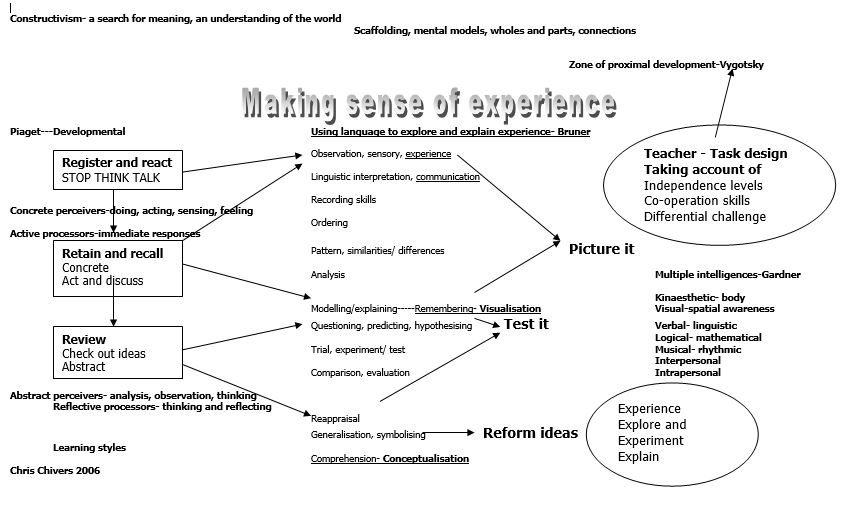Feel it, talk it, think it, explore it and then think again. Then talk some more. Talk supports all aspects of learning.
Within current education practice,are we able to give all children the start they really deserve to begin to understand the complexity of the world around them? Do we live in a society where adults have the experience base from which to be able to visualise and the articulacy to discuss what may really happen in the future? Do we have an engaged population, or one where the world around them is just part of life’s wallpaper? Are some future scenarios only understandable to an enlightened few? What does this mean for discussion and decision making by the current generation for those that come after us?
The issue of how we learn has taxed many generations of educationalists. A hundred years ago, Dewey coined the idea of visualisation as a key to learning. If one considers this idea, at its core is the idea that we need mental images that can then be manipulated to develop deeper thinking, more abstract thoughts. The ideas of Piaget were often simplified to the notion of concrete and abstract thinkers. This idea does fit with Dewey’s, in that the concrete stage is concerned with experiencing for oneself, at any age, playing with materials, artefacts, tools and seeking to understand some attributes. Gardner’s concept of multiple intelligences also has some resonance, in that any individual may have personal preferences in the means of exploration or of understanding. It is the act of personal engagement which allows the experience to be internalised, to be available for recall and redistilling with subsequent experiences, which may enhance or challenge what is “known”.
Over time, experiences will build together, with each relating to earlier ones, comparison being a key skill in processing information. To start with the premise that something similar has been seen before leads to early which has, at its base, the notion of similarity and difference. How do we learn that dogs are similar and yet different, but that collectively they are still all dogs? Simply by attributing the key elements of similarity of the species, four legs, furry coat, a head at one end, a tail at the other, and a barking sound. The differences of size and fur colour come with expanded experience, often accompanied by new names for each new breed.
Gradually internalised pictures begin to develop which can be drawn to mind when the naming word is given, so to talk of a dog will create an image of such a creature. However, will it cause the same image to be called to mind in everyone, or will some think of a terrier while others recall a Great Dane?
The simplest response to a stimulus is to describe what has been experienced, often as a single naming word. Articulacy and names of objects are vital first steps in seeking to understand anything new, especially if the thoughts are shared with others who are able to respond appropriately and to share their own insights, so we have the beginnings of discussion and collaboration in learning. Therefore the key to this approach is communication of reactions to experience, employing any appropriate form of language and a variety of associated skills.
We tend to make huge assumptions about ourselves and others, often indulge in communication limited to the superficial for fear of causing any offence by having seen things differently. Communication, discussion and reflection, often thinking aloud, are the bedrock of understanding. Are these skills valued by society as a whole? What proportion of the population falls at the first hurdle, by not engaging with the world of experiences around them?
A reflective approach to experience can be developed with questions arising that are worthy of further consideration. Exploration, experimentation including measurement and evaluation further enrich the memory bank. The learner can begin to test hypotheses, checking things for themselves. By sharing thoughts within as wide an audience as possible, these can be further refined through feedback, clarification and reorganisation to a point where the learner can be more secure in their beliefs. This accords with both Vygotsky’s and Bruner’s thinking, on language and the impact of informed outsiders reflecting back within discussion.
Life is lived for everyone as a sequence of experiences, time-bounded, and often constrained by geography. Each experience is absorbed in different ways by different people, depending on an individual’s sensory acuity, and possibly by the preferred means of accommodation of incoming information. Sight, touch, hearing, taste, smell all play a significant part in absorption of each experience. How can we know the impact of the experience on the receiver,
without them having a well developed articulacy and the active participation of the listener?
So what is the effect on school learning? How many children come to school lacking in experiences which were once able to be taken for granted, such as visiting the beach or lake, a wood or just knowing what is happening in the garden? How many of them play with toys that demand a high level of engagement, alone and with others, not just through a screen? Do they come to school with a set of visual images which are available to help them in their learning? Without these picture clues, if abstraction and imagination derives from the base of experience, how can children understand a story set in a specific setting, or think of a variety of characters if they have nothing on which to base their imaginings?
The best teachers are good storytellers, engaging with their audience, knowing their script so well that it can be adjusted to the needs of the participants. Engagement means a common understanding, shared experiences and the knowledge that each values the other. High levels of articulacy will be evident, suited to the children’s needs. The listeners will have the skills of attending and thinking alongside the teacher, sharing the common idea and might from time to time interrupt to clarify points or to embellish the telling with their own experiences. In a climate where all experiences are valued, there is a collective growing with everyone benefitting from each other’s lives.
Children, as engaged learners, can develop an articulacy that enables them access to a wide range of experiences, whatever form the experience takes. Articulacy and the ability to think for oneself are the forerunners of success at school and beyond. The current challenge is to engage children in their learning, to show them how they learn and to allow them the time, space and resources to develop into the best learners that they can become, within and without the formalised settings of classrooms. We currently have a range of structures within which we have to work, but each of these stands or falls with our ability to ensure that children are active participants in the process. It is down to teachers to lead from experience.

 RSS Feed
RSS Feed
